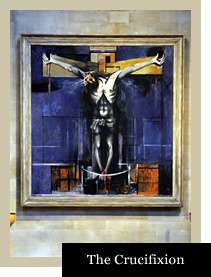
| |
"O my people, what have I done unto thee; and
wherein have I wearied thee?"
(Micah 6.3)
|
|
Having
converted to Roman Catholicism in 1926, from the time of
this painting until his death, Graham Sutherland
(1903-1980) was deeply involved in religion. Also,
from 1940 Sutherland was employed as an official
artist in World War II, as part of the
War Artists' Scheme. He worked on the Home Front,
depicting mining, industry, and bomb damage. These two
elements combined to produce this remarkable painting.
Many representations of the Crucifixion in recent
centuries fail to convey
the true
nature of the event to anyone not already familiar with
the story. (Compare, for example, the painting with the
figure in the top right-hand window above.) Many of the
old German painters produced pictures of enormous power,
but were at the same time obsessed with the physical
details - of wounds, of blood and flesh.
Sutherland seeks to bring home the horrific
reality of death by crucifixion by other means. He has
sought to avoid a purely physical obsession and yet to
bring home to his generation what the Crucifixion
involves - notice the claw-like hands, the elevated
ribcage, the deformed shins. This he has done by making
the figure to some extent formal, and not naturalistic.
There is an intrinsic nobility to Christís sacrifice
which Sutherland exploits to convey what human
sin has done, and continues to do, to distort Godís
image in us, and his plan for the redemption of the
world.
For Sutherland the Crucifixion is not just an
historical event which took place two thousand years
ago. It is also a present reality - the very
constructional Cross suggests the present day. But for
the greater part the background is simply of unspecified
time and space.
A similar idea is suggested by the sharp contrast
between the high relief of the figure and the flatness
of the rest, reminiscent of the effect of a Greek or
Russian icon. The figure is alone, without family or
friends, like so many prisoners who die alone through
intimidation, torture, through violence in political
circumstances. The head is bowed, in death, perhaps,
though blood still drains from his hands evoking the
crimson of Isaiah, chapter 63. To either side are two
pockets of blackness suggesting the two thieves who died
beside Christ.
At the foot of the Cross, the suggestion of a
brick wall emphasizes the background of civilization
against which Christ is crucified. The little railing
serves the double purpose of stressing the sacredness of
the event and, at the same time, associating the
spectator with what is going on.
Initially the picture is best seen from the centre of
the nave, or from the north transept opposite. The scale
of the picture, set within its cavernous space,
powerfully draws the viewer in.
The design and colouring of the picture suggest,
particularly on increasing acquaintance, something of
the dignity and majesty of the event. This would hardly
be a first impression on being confronted with Calvary,
but would spring from closer insight and longer
meditation. The colour of the background is most
satisfying, and enables us to move away from the
contorted agony of Christís body when it becomes too
much for us. In the blue we find a sense of hope and a
hint that there is something more, and that our own darknessess may be overcome.
In 2003 the painting was removed from church for the
first time to Olympia, London, to be the focal point for
the exhibition commemorating the centenary of the
artistís birth. From there it was exhibited at
Tate Modern for the duration of remedial works
necessitating the closure of the church. During the
process of removal it became apparent that the picture
was too large to leave the building in one piece, as it
were, and that the picture had been framed in church
presumably without regard for it ever being taken out.
Graham Sutherlandís depiction of the Crucifixion
of Christ was the gift of The Rev'd Walter Hussey,
Vicar of St Matthewís between 1937 and 1955. It is painted
on boards as canvas of sufficient quality was not
available at the time.
Mass is sometimes celebrated under this painting on
weekdays, and it is a focus for prayer and devotion
during Passiontide and Holy Week in particular.
|









